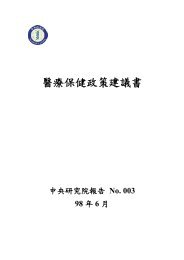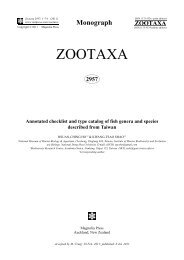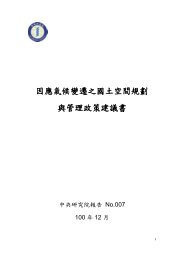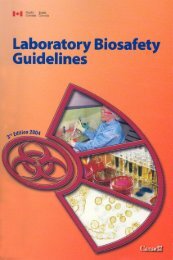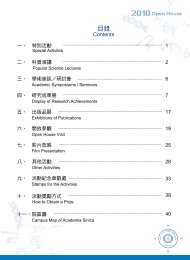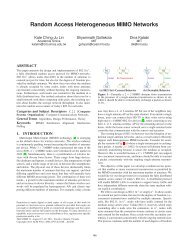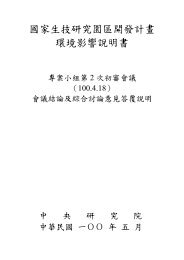Targeted Drug Delivery Systems Mediated by a ... - Academia Sinica
Targeted Drug Delivery Systems Mediated by a ... - Academia Sinica
Targeted Drug Delivery Systems Mediated by a ... - Academia Sinica
You also want an ePaper? Increase the reach of your titles
YUMPU automatically turns print PDFs into web optimized ePapers that Google loves.
<strong>Targeted</strong> <strong>Drug</strong> <strong>Delivery</strong> to Breast Cancerpeptides. After washing in PBS with 0.1% Tween 20 (PBST0.1),sections were treated with anti-M13 mouse mAb (GE Healthcare)for 1 hour at room temperature. Following washing in PBST0.1, abiotin-free super sensitive polymer-HRP detection system (Biogenex)was used to detect immunoreactivity. The slides werelightly counterstained with hematoxylin, mounted with Aquatex(Merck) and examined <strong>by</strong> light microscopy. The percentage ofpositive staining cells was quantified and labeling index (LI) ofeach section was judged <strong>by</strong> the medical pathologist of NTUH.Synthesis of SP90-PEG-DSPE Conjugates8.5 mg of NHS-PEG-DSPE [N-hydroxysuccinimido-carboxylpolyethyleneglycol (MW, 3400)-derived distearoylphosphatidylethanolamine] (NOF Corporation) dissolved in 0.25 ml ofdichloromethane (Sigma-Aldrich) was added to 0.25 ml of DMSO(Sigma-Aldrich) containing 3.1 mg of SP90 peptide. This was thenmixed with 0.011 ml of triethylamine (Sigma-Aldrich) to catalyzethe reaction. The stoichiometric molar ratio of SP90 and NHS-PEG-DSPE was 1.1:1. The reaction was carried out for 72 hoursat room temperature. The SP90-PEG-DSPE conjugates werepurified <strong>by</strong> dialysis with a 2 kDa cut-off membrane (Spectrum),and were then dried through lyophilization.To determine the percentage of conjugation between PEG andSP90, equal concentrations of SP90, NHS-PEG-DSPE and SP90-PEG-DSPE conjugates prior to purification were subjected toelectrophoresis on a Tricine-SDS polyacrylamide gel (20%acrylamide; 6% crosslinker, relative to the total concentration),as modified from a previous paper [37]. Precision Plus ProteinDual Xtra Standards (Bio-Rad) were used as protein markers.Coomassie blue and barium iodide staining were used to detectpeptide and PEG molecules, respectively. After Coomassie bluestaining, gels were rinsed with ddH 2 O, and immersed in 5% (w/v)barium chloride solution (Sigma-Aldrich) for 10 min. After asecond rinse with ddH 2 O, the gel was placed in 0.05 M iodinesolution (Sigma-Aldrich) for color development. The conjugatewas also analyzed <strong>by</strong> MALDI-TOF-MS (BRUKER microflex)operated in the linear mode. The matrix used was a-cyano-4-hydroxycinnamic acid (HCCA).Preparation of SP90-conjugated Liposomal NanoparticlesA lipid film hydration method was used to prepare PEGylatedliposomes composed of distearoylphosphatidylcholine, cholesterol,and PEG-DSPE, which were then used to encapsulate doxorubicin(Sigma-Aldrich) or to incorporate sulforhodamine B-DSPE(Avanti) [25,36]. After preparation, the liposomes contained 110to 130 mg doxorubicin per mmol phospholipid and had a particlesize ranging from 65 to 75 nm in diameter. SP90-PEG-DSPE wassubsequently incorporated into pre-formed liposomes <strong>by</strong> coincubationat 60uC, the transition temperature of the lipid bilayer,for 1 hour with gentle shaking. After incubation, the surface ofeach liposome displayed about 500 peptide molecules. Sepharose4B (GE Healthcare) gel filtration chromatography was used toremove released free drug, unconjugated peptides, and unincorporatedconjugates. Doxorubicin concentrations in the fractions ofeluent were determined <strong>by</strong> measuring fluorescence at lEx/Em = 485/590 nm using a spectrofluorometer (Spectra Max M5,Molecular Devices).MTT Cell Proliferation AssayBT483 cells were seeded in 96-well plates (5000 cells/well) inDMEM media and were incubated overnight. After 24 hours,supernatants were removed and cells were treated with differentconcentration of drug in 2% FBS/DMEM for 72 hours. At theend of time point, 50 ml of MTT (Thiazolyl Blue TetrazoliumBromide; Sigma-Aldrich) was added to each well of the plate andwas incubated for 3.5 hours. After incubation, 150 ml of Dimethylsulfoxide (DMSO; Mallinckrodt Baker) was added to each well for10 min, and the absorbance was determined with microplatereader (SpectraMax M5, Molecular Devices) at 540 nm.Synthesis of SP90-conjugated Quantum Dots (SP90-QD)Qdot 800 ITK amino PEG quantum dots (Invitrogen) wereused in this study. The procedures for synthesis of ligandconjugatedQDs were described in a previous study [38]. Briefly,QDs were conjugated to sulfo-SMCC (Sulfosuccinimidyl-4-(Nmaleimidomethyl)cyclohexane-1-carboxylate; Thermo Scientific)to generate a maleimide-activated surface on the QD, and freesulfo-SMCC was then removed using a NAP-5 desalting column(GE HealthCare). SP90 peptide were thiolated (addition ofsulfhydryl) using Traut’s reagent (Thermo Scientific), and thenpurified with HPLC. Subsequently, the maleimide-functionalizedQDs were incubated with SP90-SH at 4uC overnight. SP90-conjugated QDs were purified using a NAP-5 desalting column toremove any free peptides. The concentration of quantum dots wasexamined using a spectrofluorometer, and calculated throughinterpolation using a standard curve.Uptake of SP90-LD <strong>by</strong> Human Breast Cancer CellsTumor cells were grown on a 24-well plate to 90% confluency,and 2.5 mg/ml SP90-LD or LD in complete culture medium wasadded. The cells were incubated at 37uC, for the following periodsof time: 1, 2, 4, 8, 16, 32 and 48 hours. At the indicated time point,cells were washed with PBS, and SP90-LD or LD on the cellsurface was removed <strong>by</strong> adding 0.1 M Glycine, pH 2.8 for10 min. Cells were then lysed with 200 ml 1% Triton X-100. Forextraction of doxorubicin, 300 ml IPA (0.75 N HCl in isopropanol)was added to the lysate and shaken for 30 min. After the lysate wascentrifuged at 12,000 rpm for 5 min, total doxorubicin wasdetermined <strong>by</strong> measuring fluorescence at l Ex/Em = 485/590 nmusing a spectrofluorometer (SpectraMax M5, Molecular Devices).The concentration of doxorubicin was calculated <strong>by</strong> interpolationusing a standard curve.Animal Model for the Study of Ligand-targeted TherapyAnimal care was carried out according to guidelines established<strong>by</strong> <strong>Academia</strong> <strong>Sinica</strong>, Taiwan. The protocol was approved <strong>by</strong> theCommittee on the Ethics of Animal Experiments of <strong>Academia</strong><strong>Sinica</strong> (Permit Number: MMi-ZOOWH2009102). Mice 4–6weeks old were injected subcutaneously in the dorsolateral flankwith human breast cancer cells. Mice with size-matched tumors(approximately 75 mm 3 ) were then randomly assigned to differenttreatment groups, and were injected with either liposomaldoxorubicin (LD), SP90-conjugated liposomal doxorubicin(SP90-LD), free doxorubicin (FD) or equivalent volumes of salinethrough the tail vein. The dosage of doxorubicin was 3 mg/kginjected once a week for three weeks (on days 0, 7 and 14). Micebearing large tumors (approximately 500 mm 3 ) were treated withSP90-LD, LD or FD through tail vein injection, at a dose of 3 mg/kg twice a week, for a total dose of 9 mg/kg. Mouse body weightand tumor size were measured twice a week. At the end of theexperiment, tumor tissue and the visceral organs of each mousewere removed and fixed with 3% formaldehyde, and OCT wasembedded for further histopathological examination.For the breast cancer orthotopic model, 1610 7 MCF-7-Luc(clones stably expressing luciferase) cells mixed with matrigel (BD)were orthotopically injected into the right inguinal mammary fatpad of each female SCID mouse. Once tumor size reached 500mm 3 , the mice were treated with either SP90-LD, FD or LD <strong>by</strong>PLOS ONE | www.plosone.org 3 June 2013 | Volume 8 | Issue 6 | e66128



